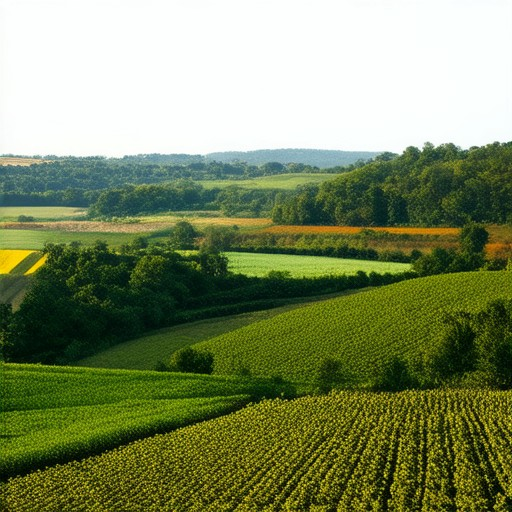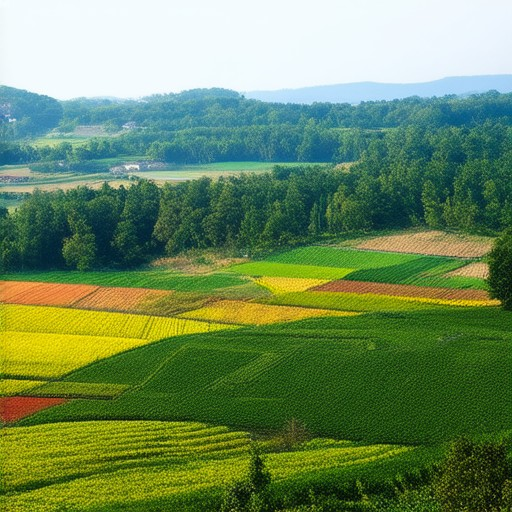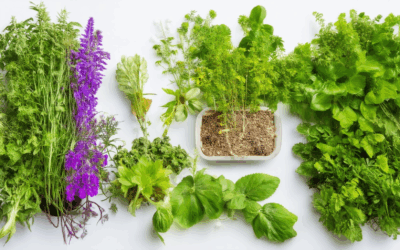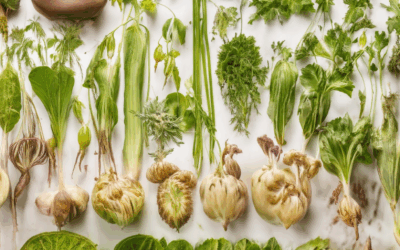Exploring the realm of sustainable agriculture, it becomes clear that adopting low-impact farming techniques is not just a trend but a necessity for future food security and environmental preservation. With global concerns over climate change and resource depletion, farmers worldwide are seeking eco-friendly practices that balance productivity with sustainability. Low-impact farming techniques offer a pathway to reducing environmental strain while maintaining crop yields and ensuring long-term agricultural viability. From innovative farming methods to time-tested practices, this article delves into the strategies and principles that define sustainable agriculture, highlighting how these approaches can contribute to a healthier planet and a resilient food system.
Key Takeaways
- **Sustainable Agriculture Techniques**: Implement crop rotation, cover cropping, conservation tillage, agroforestry, water conservation, integrated pest management, vertical farming, and urban farming to enhance environmental health and productivity.
- **Most Environmentally Friendly Practices**: Opt for organic farming, agroforestry, crop rotation, integrated pest management, and water conservation to minimize environmental impact and promote biodiversity.
- **Permaculture Overview**: Embrace a holistic approach that mimics natural ecosystems, integrating plants, animals, and human systems for sustainable living and eco-friendly practices.
- **Earth Care Principle**: Focus on regenerating land through composting, agroforestry, and soil-building to enhance ecological health.
- **People Care Principle**: Prioritize human well-being by fostering relationships and supporting mutual growth within communities.
- **Fair Share Principle**: Work towards equitable resource distribution and local economies to ensure fair access and sustainability.
- **Permaculture History**: Originated with Bill Mollison’s 1981 book, evolving into a global movement for diverse applications in farming and urban settings.
- **Key Components of Permaculture**: Integrate plants, animals, people, and structures designed for local sustainability and resilience.
- **Environmental Benefits of Permaculture**: Reduce chemical use, enhance biodiversity, and sequester carbon to promote ecological balance.
- **Economic Benefits of Permaculture**: Lower costs, increase food security, and create local jobs through sustainable practices.
- **Social Benefits of Permaculture**: Strengthen community bonds and provide access to fresh, organic foods, fostering healthy living.
- **Real-World Applications**: Transform urban spaces into green gardens and support farmsteads producing local goods for communities.
What is the Most Sustainable Farming Method?
Old Seed advocates for regenerative farming practices that emphasize environmental health, biodiversity, and long-term productivity. Among various sustainable farming methods, the following stand out as highly effective:
- Organic Agriculture : This method avoids synthetic pesticides, fertilizers, and genetically modified organisms, promoting natural processes to maintain soil health and crop diversity.
- Agroforestry : Integrating trees with crops and livestock enhances soil fertility, reduces erosion, and creates habitats for pollinators and wildlife.
- Crop Rotation : Rotating crops helps control pests, improves soil nutrients, and reduces the need for chemical inputs, making farming systems more resilient.
- Integrated Farming : Combining crops, livestock, and forestry practices maximizes resource efficiency and creates a self-sustaining ecosystem.
- Traditional Seed Preservation : Maintaining heirloom and native seeds ensures genetic diversity, adaptability, and resilience in changing environments.
Sustainable farming methods like these not only protect the environment but also enhance food production and community well-being. By adopting these practices, farmers can contribute to a healthier planet and a more secure food supply for future generations.
For more insights into sustainable farming techniques and resources, explore Old Seed’s comprehensive guide .
Types of Agriculture with Low Environmental Impact
Agriculture plays a significant role in shaping the environment, both positively and negatively. Certain farming practices and types of agriculture have been shown to have a lower environmental impact due to their sustainable methods and reduced resource consumption. Here are some examples:
1. Sustainable Agriculture
- Sustainable agriculture focuses on practices that maintain soil health, conserve water, and reduce air pollution. Techniques include crop rotation, organic farming, and agroforestry.
- By avoiding synthetic pesticides and fertilizers, sustainable agriculture minimizes contamination of water sources and reduces greenhouse gas emissions associated with chemical production.
2. Organic Farming
- Organic farming is widely recognized for its lower environmental impact compared to conventional farming. It excludes genetically modified organisms (GMOs), synthetic pesticides, and artificial fertilizers.
- Organic farms often rely on crop rotation and natural pest control methods, which preserve biodiversity and reduce the need for external inputs.
3. Vertical Farming and Hydroponics
- Vertical farming and hydroponic systems grow plants in controlled environments without the need for arable land or extensive water resources.
- These methods reduce energy consumption, minimize waste, and decrease the carbon footprint associated with transporting produce over long distances.
4. Integrated Farming Practices
- Integrated farming combines crop production with livestock raising and other agricultural activities. This approach enhances resource efficiency and reduces environmental degradation.
- Practices like crop rotation and agroforestry help maintain soil fertility and sequester carbon dioxide, contributing to a healthier ecosystem.
5. Urban and Community Farming
- Urban farming involves growing fruits, vegetables, and herbs in cities, often in containers or rooftop gardens. This reduces the need for long-distance transportation and lowers energy costs associated with refrigeration and storage.
- Community-supported agriculture (CSA) models allow consumers to subscribe to weekly shares of fresh produce, supporting local farmers and reducing food miles.
6. Regenerative Agriculture
- Regenerative agriculture focuses on rebuilding soil health and increasing biodiversity through practices like cover cropping, composting, and planting native species.
- This method improves soil resilience, reduces erosion, and sequesters carbon, making it a highly sustainable option.
Benefits of Low-Environmental Impact Agriculture
- Reduces greenhouse gas emissions.
- Conserves water and minimizes pollution.
- Enhances biodiversity and supports eco-friendly practices.
- Decreases reliance on synthetic chemicals and non-renewable resources.
By adopting these practices, farmers can contribute to a healthier planet while producing safe, nutritious food for their communities. Old Seed offers valuable resources on heirloom gardening and sustainable farming techniques to help individuals and families get started.
How to Reduce the Impact of Farming
Farming plays a significant role in shaping our environment, but it can also have negative impacts if not practiced sustainably. Here are effective ways to minimize the environmental footprint of farming operations:
- Reduce Chemical Use: Minimize the reliance on synthetic pesticides and herbicides. These chemicals can leach into water supplies, harming aquatic life and contributing to algal blooms. Consider organic alternatives like compost and natural fertilizers to maintain soil health.
- Adopt Conservation Tillage: Practice reduced or conservation tillage to preserve soil structure and prevent erosion. Covering soil with mulch can retain moisture and suppress weeds, reducing the need for chemical treatments.
- Implement Crop Rotation: Rotate crops to balance nutrient uptake and disrupt pest cycles. Different crops have varying root structures and nutrient requirements, ensuring soil health and preventing depletion.
- Use Cover Crops: Plant cover crops like clover or rye grass during off-seasons to protect soil from erosion and add organic matter. These crops grow quickly and provide a green cover that aids in soil regeneration.
- Practice Integrated Farming: Integrate crops with livestock to maximize resource use and reduce waste. Manure from animals serves as a natural fertilizer, enhancing soil fertility and biodiversity.
- Optimize Water Usage: Invest in efficient irrigation systems such as drip irrigation or rainwater harvesting to conserve water. These methods apply water directly to plants with minimal evaporation.
- Sustainable Livestock Practices: Raise animals in grass-fed systems rather than confined environments. Rotational grazing helps maintain healthy pastures and reduces overgrazing, preserving soil integrity.
- Certify Sustainable Practices: Seek certification through programs like USDA Organic or Fair Trade. These certifications demonstrate commitment to environmental stewardship and can enhance market appeal.
- Advocate for Sustainable Policies: Join organizations advocating for policies that support sustainable farming, such as the National Sustainable Agriculture Coalition. These efforts can lead to incentives and regulations promoting eco-friendly practices.
- Share Knowledge and Resources: Participate in farmer networks and workshops to share sustainable farming techniques. Collaborative learning can lead to widespread adoption of eco-friendly practices.
The Best Sustainable Agriculture Techniques
Sustainable agriculture focuses on practices that enhance environmental health, conserve resources, and promote long-term food security. Here are some of the most effective techniques:
- Crop Rotation : Rotating crops helps maintain soil fertility and reduces the risk of pests and diseases. For example, alternating between legumes and cereals improves nitrogen levels in the soil.
- Cover Cropping : Planting cover crops like clover or rye keeps the soil covered during off-seasons, reducing erosion and improving soil organic matter.
- Conservation Tillage : Minimizing tillage reduces soil disturbance, preserving its structure and preventing erosion. This practice also saves fuel and reduces greenhouse gas emissions.
- Agroforestry : Integrating trees with crops and livestock enhances biodiversity, improves soil health, and provides shade and erosion control. Learn more .
- Water Conservation : Techniques like drip irrigation and rainwater harvesting help reduce water usage and minimize waste. Explore these methods .
- Integrated Pest Management : Using biological controls and crop rotation to manage pests reduces reliance on chemical pesticides, promoting healthier ecosystems and better yields.
- Vertical Farming : Growing crops in stacked layers or containers uses less land and resources, making urban farming feasible. Discover how it works .
- Urban Farming : Converting unused spaces in cities into productive farms contributes to local food production and community engagement. Find tips and resources .
Sustainable agriculture isn’t just about the environment—it’s also about ensuring food security and economic stability for future generations. By adopting these practices, farmers can thrive while protecting the planet.
Most Environmentally Friendly Agriculture Practice
The most environmentally friendly agriculture practice depends on various factors, but several methods stand out for their positive impact on the environment:
- Organic Farming : This practice avoids synthetic chemicals like pesticides and fertilizers, promoting natural processes and reducing pollution. It also enhances soil health and biodiversity.
- Agroforestry : Combines trees with crops and livestock, helping to sequester carbon, reduce erosion, and promote biodiversity while improving soil fertility.
- Crop Rotation : Reduces soil degradation and pest resistance by alternating different crops, minimizing the need for external inputs and preserving agricultural diversity.
- Integrated Pest Management (IPM) : Uses biological control agents and crop rotation to manage pests, reducing reliance on harmful chemicals and supporting ecosystem balance.
- Water Conservation Techniques : Practices like drip irrigation and rainwater harvesting help preserve water resources while maintaining crop yields.
- Cover Cropping : Planting cover crops between main crops improves soil structure, reduces erosion, and enhances nutrient cycling, benefiting both the environment and future harvests.
- Permaculture : A sustainable farming method that mimics natural ecosystems, focusing on polycultures of plants and animals to create self-sustaining systems while restoring degraded land.
These practices collectively contribute to healthier ecosystems, reduced resource depletion, and long-term agricultural sustainability. By adopting a combination of these methods, farmers can minimize their environmental footprint while producing food efficiently.
For more information on sustainable farming techniques, visit our sustainable farming guide .
What is Permaculture?
Permaculture is a design system for ecological and sustainable living that integrates plants, animals, people, buildings, and communities into harmonious, self-sustaining systems. It focuses on mimicking natural ecosystems to create resilient environments that support life and reduce our ecological footprint.
Core Principles of Permaculture
- Earth Care: Regenerating and restoring the health of the land through sustainable practices like composting, agroforestry, and soil building.
- People Care: Recognizing the importance of human well-being and fostering relationships that support mutual growth and prosperity.
- Fair Share: Sharing abundance and working towards equitable distribution of resources within the community.
- Rebuilding Local Economies: Promoting local trade, organic production, and self-reliance to strengthen community resilience.
History and Origins
- The concept of permaculture was first introduced by Bill Mollison in his 1981 book “Permaculture: A Design for Human Survival.”
- Mollison drew inspiration from traditional farming practices and natural ecosystems, aiming to create systems that could survive and thrive indefinitely.
- Over time, permaculture has evolved into a global movement, with diverse applications ranging from urban gardening to large-scale farmsteads.
Key Components of Permaculture Systems
- Plants: Selecting species that are suited to the local climate and ecosystem, often focusing on nitrogen-fixing plants, herbs, fruits, and nuts.
- Animals: Incorporating chickens, ducks, bees, and other animals to enhance pollination, fertilization, and pest control.
- People: Designing systems that are accessible and beneficial for humans, ensuring that the system supports human needs while also supporting nature.
- Structures: Building with materials that are locally available and sustainable, such as cob, straw bale, and wood.
Benefits of Permaculture
- Environmental Benefits: Reduces chemical use, enhances biodiversity, and sequesters carbon.
- Economic Benefits: Lowers costs, increases food security, and creates local jobs.
- Social Benefits: Strengthens community bonds and promotes healthy living through access to fresh, organic foods.
Real-World Applications
- Urban gardens transforming empty lots into productive green spaces.
- Farmsteads producing meat, eggs, milk, and other products for local markets.
- Community projects that provide shared resources and education.
Conclusion
Permaculture is more than just a gardening method—it’s a lifestyle choice that promotes sustainability, resilience, and harmony with the Earth. By adopting permaculture practices, individuals and communities can create systems that support both human well-being and ecological health for generations to come.
For more information and resources on implementing permaculture, visit Old Seed and explore their guides on heirloom gardening and sustainable agriculture.








0 Comments